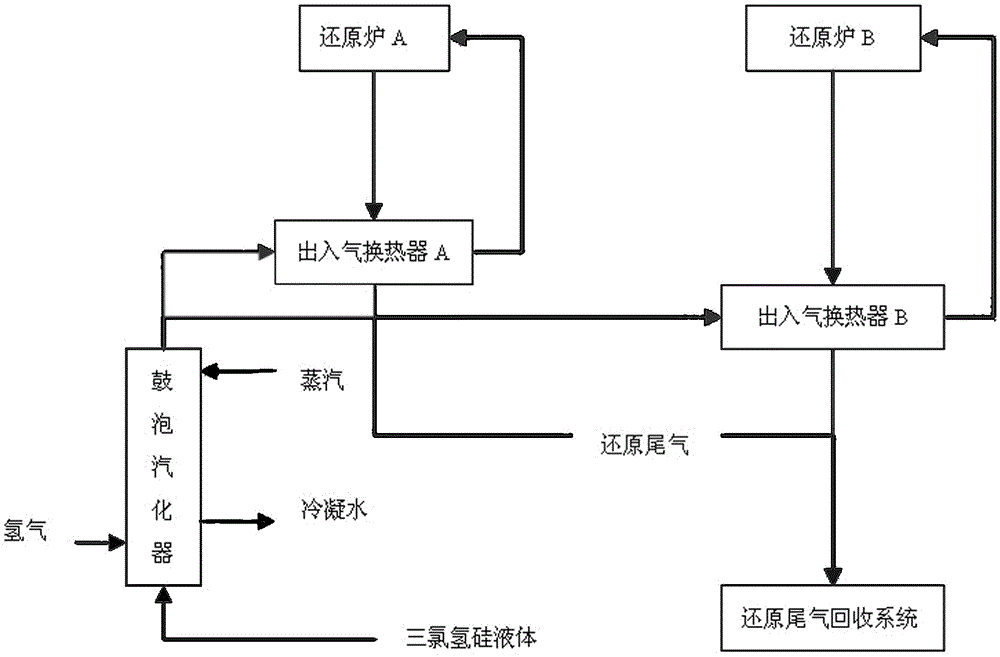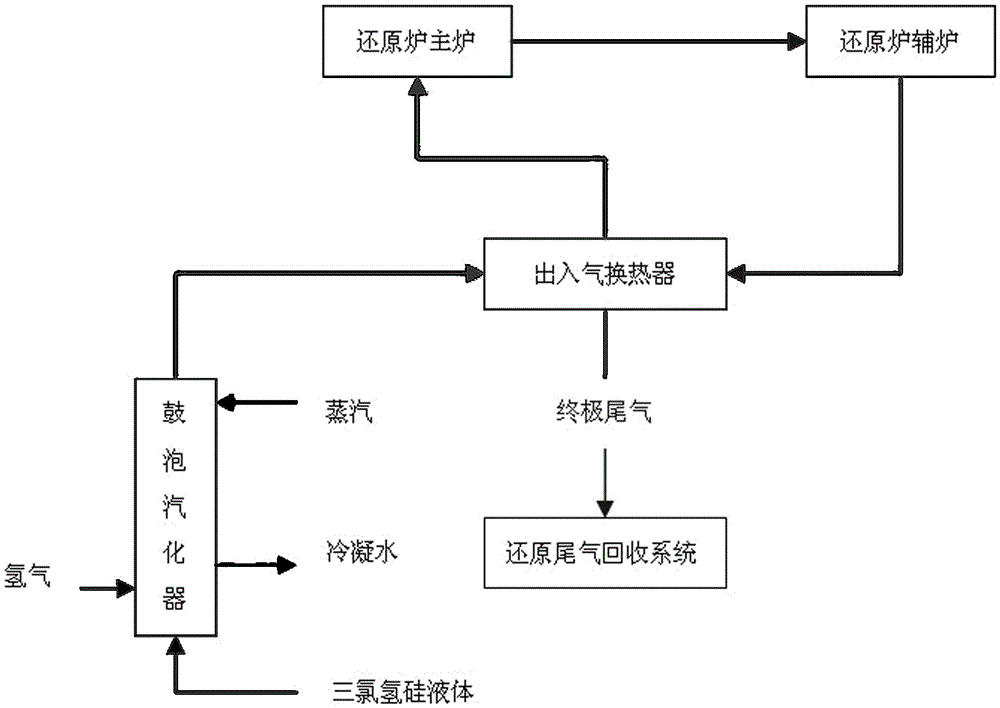A polysilicon production process and a production system for the process
A production process, polysilicon technology, applied in the direction of silicon compounds, inorganic chemistry, non-metallic elements, etc., can solve the problems of increased metal impurity precipitation, high core temperature of silicon rods, loss of raw materials, etc., to prevent cauliflower material and improve supersaturation. Effect
- Summary
- Abstract
- Description
- Claims
- Application Information
AI Technical Summary
Problems solved by technology
Method used
Image
Examples
Embodiment 1
[0035] Such as figure 1 As shown, refined trichlorosilane and hydrogen are mixed in the bubbling vaporizer 4. By controlling the pressure and temperature of the bubbling vaporizer 4, the ratio of the molar ratio of hydrogen to refined trichlorosilane is 3:1 to be delivered to the inlet and outlet gas. Heat exchanger 3.
[0036] The mixed gas feed entering and exiting the gas heat exchanger 3 exchanges heat with the high-temperature ultimate tail gas from the auxiliary furnace 2 of the CVD reduction furnace, which not only increases the feed temperature but also reduces the ultimate tail gas temperature.
[0037] After the mixed gas feed is heated by the final exhaust gas from the auxiliary furnace 2 of the CVD reduction furnace, it continues to enter the main furnace 1 of the CVD reduction furnace, and reacts on the surface of the silicon core at 1150°C in the main furnace 1 of the CVD reduction furnace to generate polysilicon.
[0038] The by-product of the main furnace 1 of the CV...
Embodiment 2
[0042] Such as figure 1 As shown, refined trichlorosilane and hydrogen are mixed in the bubbling vaporizer 4, and by controlling the pressure and temperature of the bubbling vaporizer 4, the ratio of the molar ratio of hydrogen to refined trichlorosilane is 4:1 to be delivered to the inlet and outlet gas. Heat exchanger 3.
[0043] The mixed gas feed entering and exiting the gas heat exchanger 3 exchanges heat with the high-temperature ultimate tail gas from the auxiliary furnace 2 of the CVD reduction furnace, which not only increases the feed temperature but also reduces the ultimate tail gas temperature.
[0044] After the mixed gas feed is heated by the final exhaust gas from the auxiliary furnace 2 of the CVD reduction furnace, it continues to enter the main furnace 1 of the CVD reduction furnace, and reacts on the surface of the silicon core at 1150°C to form polysilicon in the main furnace.
[0045] The by-product of the main furnace 1 of the CVD reduction furnace is used as ...
Embodiment 3
[0049] Such as figure 1 As shown, refined trichlorosilane and hydrogen are mixed in the bubbling vaporizer 4. By controlling the pressure and temperature of the bubbling vaporizer 4, the ratio of the molar ratio of hydrogen to refined trichlorosilane is 3.5:1 to be delivered to the inlet and outlet gas. Heat exchanger 3.
[0050] The mixed gas feed entering and exiting the gas heat exchanger 3 exchanges heat with the high-temperature ultimate tail gas from the auxiliary furnace 2 of the CVD reduction furnace, which not only increases the feed temperature but also reduces the ultimate tail gas temperature.
[0051] After the mixed gas feed is heated by the final exhaust gas from the auxiliary furnace 2 of the CVD reduction furnace, it continues to enter the main furnace 1 of the CVD reduction furnace, and reacts on the surface of the silicon core at 1150°C to form polysilicon in the main furnace.
[0052] The by-product of the main furnace 1 of the CVD reduction furnace is used as th...
PUM
 Login to View More
Login to View More Abstract
Description
Claims
Application Information
 Login to View More
Login to View More - R&D
- Intellectual Property
- Life Sciences
- Materials
- Tech Scout
- Unparalleled Data Quality
- Higher Quality Content
- 60% Fewer Hallucinations
Browse by: Latest US Patents, China's latest patents, Technical Efficacy Thesaurus, Application Domain, Technology Topic, Popular Technical Reports.
© 2025 PatSnap. All rights reserved.Legal|Privacy policy|Modern Slavery Act Transparency Statement|Sitemap|About US| Contact US: help@patsnap.com



